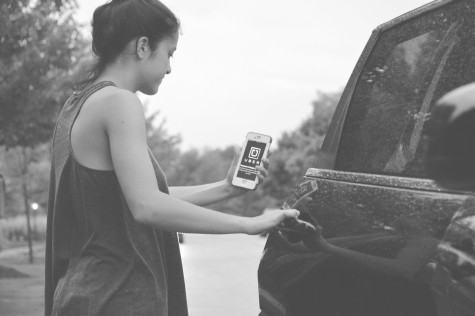Questions about Uber safety emerge

While smiling sheepishly, senior Austin Fialkow said that he continues to use Uber, despite the fact that he does not feel entirely safe.
Fialkow said taking Uber, the transportation service that makes rides accessible through a smartphone application, is worth the potential safety risk.
“[Using Uber] feels a little less safe than taking a cab because you don’t know whose car you are going to get into,” Fialkow said.
Former Uber driver Matt Rissien has not driven for Uber for over a year and a half, but he was a driver for a year because he wanted to meet people that he otherwise would not meet.
“I’ve always had pretty good encounters with the [other] drivers, but I know that [safety issues] have gotten a lot worse lately,” Rissien said.
Junior Callie Williams likes Uber because she knows it performs background checks on its drivers to ensure the safety of its customers.
“If you get in the car and you feel uncomfortable, you can ask them to pull over immediately and can get out [of the vehicle],” said Williams. “You can write a report, and [Uber takes] the report seriously.”
Williams said she uses Uber three to four times a month when she does not have another mode of transportation, but Williams was unaware that her use of Uber violates its User Terms.
Lauren Altmin, a spokesperson for Uber, said people “under the age of 18 are not permitted to use the app unless they are accompanied by an account holder over the age of 18.”
Altmin also said Uber is one of the safest, most reliable ways to get around because Uber’s technology enables it to “focus on safety for riders and driver partners before, during and after a trip in ways that [other transportation companies] cannot.”
According to Altmin, every Uber driver must undergo an extensive background check as one of Uber’s many safety precautions.
Despite Altmin’s assurances regarding Uber’s safety, Uber has faced legal issues.
The revised version of a lawsuit addressing Uber’s safety was filed on August 18, 2015, by the district attorneys for San Francisco and Los Angeles, according to Hoon Chun, assistant head deputy for the Consumer Protection Division of the Los Angeles District Attorney’s Office.
The lawsuit states that the criminal histories of Uber drivers include “convictions for murder, sex offenses, kidnapping, assault, robbery, burglary, fraud and identity theft” in the state of California alone.
“The goal of the lawsuit is to require Uber to make accurate and non-misleading statements about their background checks,” Chun said.
According to Maxwell Szabo, spokesperson for the San Francisco District Attorney’s Office, the lawsuit’s purpose is not to make assertions regarding Uber’s safety.
“[Uber is] misleading consumers into thinking they have a sense of safety that may or may not exist,” Szabo said.
To ensure that she does not experience any potential threats to her own safety, Williams said she and her friends have developed a system.
“[When my friends and I use Uber], there are always going to be two or more people in the car because we don’t know the person who is driving, and we don’t want to be alone with someone we don’t know,” Williams said.
Fialkow recognizes the validity of these safety concerns and said he has noticed that Uber drivers get angry when customers terminate their rides at the last minute.
“Constantly, I get yelled at by [drivers] for cancelling,” Fialkow said.
Nonetheless, he said he intends to continue using Uber because when safety issues arise, they serve as a “one-and-a-million” occurrence.
According to Altmin, Uber drivers worldwide complete more than one million rides per day.

